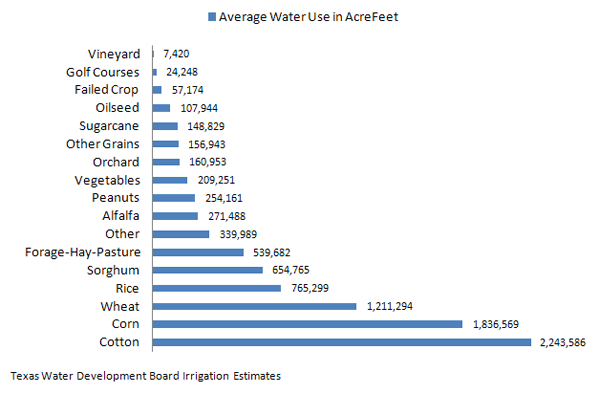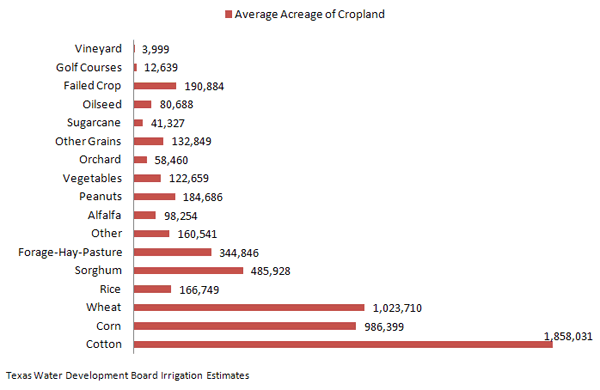Agricultural Workgroup
Follow Agricultural BMP Development Here.
The Water Conservation Advisory Council (Council) is initiating an effort to invite agricultural stakeholders to participate in activities and discussions on the following topics areas:
- Evaluating and defining metrics for agricultural water uses,
- improving resource information such as developing agricultural Best Management Practices (BMPs)
- improving awareness and recognition for agricultural water conservation
- identifying case studies and trends in agricultural water conservation efforts
- studying/measuring the success and implementation of BMPs
- identifying barriers & solutions to conserving irrigation water
The Council would like to engage the agriculture sectors that use the greatest volumes of water. Within the agricultural arena water conservation goals can be achieved without severe restrictions on irrigation and damaging impacts on the economy. In fact, Texas producers are already taking the lead in conservation efforts by investing in new technology and implementing practices that reduce the amount of water used per acre. In many areas, Texas producers have already been able to reduce their water use or use it more efficiently.
Reducing water usage through more efficient equipment and practices brings cost benefits to producers as well as significant public benefits. The economic activity generated by irrigated agriculture creates tens of thousands of jobs in Texas. Implementing water conserving practices maximizes the economic benefit from each gallon of water that is pumped, and extends those benefits and jobs for generations to come.
Annual Irrigation Estimates5-yr average Irrigation Water Use in Acre-Feet (2005-2009)

Annual Irrigation Estimates5-yr average Irrigated Acres (2005-2009)

Evaluation of Water Use Metrics
The Council would like to host discussions with agricultural stakeholder groups in order to evaluate current metrics and define possible new metrics for calculating agricultural water use. Currently agricultural water use estimates are calculated using the universal metric of acre foot per acre of irrigated crop land. To better understand agricultural water use it is necessary to use consistent terminology and consistent methodologies to compute water use data.
One area where the council would like to take a closer look at is using a metric that is based on a Unit of Production. For example, the number of gallons required to grow a bushel of wheat, or the number of gallons required to raise a pound of beef.
The council would like to invite key stakeholder groups to the table in order to involve them in discussions of developing metrics for various agricultural applications.
Water Conservation Best Management Practices
The Best Management Practices Guide (BMP Guide) currently has 21 agricultural BMPs. These were originally developed and adopted in 2004. It is our intent to review, update and expand the Guide to include additional water conservation best practices resulting from improvements in technology and from subsequent research in agricultural water use. The Council is currently considering some specific updates and modifications to the BMP Guide that will better provide guidance and information to users.
For example one enhancement that is expected to be made to the guide is to incorporate some information on the Determination of the Impact on Other Resources. We have learned that water conservation often has other important resource impacts such as infrastructure costs, operating and maintenance cost savings, energy savings and personnel issues. Therefore we believe it is important to recognize the impacts associated with water conservation practices.
Public Awareness
Across Texas there are many water conservation public awareness efforts taking place. Having an effective public awareness campaign with media messaging, outreach events and efforts, and resource tools are all strategies that help achieve a measure of success in water conservation. To achieve long-term water conservation in Texas, it will be essential to involve all water user groups. Within the agricultural arena there are many examples of leadership in water conservation. However, to meet the expected water demands and needs for the next 50 years agricultural water users will need to seek more opportunities to optimize water conservation efforts while maintaining sustainable economic yields.
For additional enhancements, the Council would like to supplement the guide with actual case studies. Case studies will serve to identify those who have achieved a measure of conservation success. These case studies are an example for others to follow and allow other water users to identify possible expertise as a resource for those wishing to implement a water conservation practices.